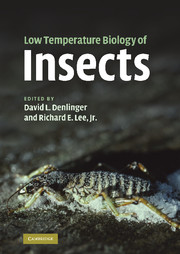Book contents
- Frontmatter
- Contents
- List of contributors
- Preface
- PART I PHYSIOLOGICAL AND MOLECULAR RESPONSES
- 1 A primer on insect cold-tolerance
- 2 Rapid cold-hardening: Ecological significance and underpinning mechanisms
- 3 Antifreeze and ice-nucleator proteins
- 4 Genomics, proteomics and metabolomics: Finding the other players in insect cold-tolerance
- 5 Cell structural modifications in insects at low temperatures
- 6 Oxygen: Stress and adaptation in cold-hardy insects
- 7 Interactions between cold, desiccation and environmental toxins
- PART II ECOLOGICAL AND EVOLUTIONARY RESPONSES
- PART III PRACTICAL APPLICATIONS
- Index
- References
3 - Antifreeze and ice-nucleator proteins
from PART I - PHYSIOLOGICAL AND MOLECULAR RESPONSES
Published online by Cambridge University Press: 04 May 2010
- Frontmatter
- Contents
- List of contributors
- Preface
- PART I PHYSIOLOGICAL AND MOLECULAR RESPONSES
- 1 A primer on insect cold-tolerance
- 2 Rapid cold-hardening: Ecological significance and underpinning mechanisms
- 3 Antifreeze and ice-nucleator proteins
- 4 Genomics, proteomics and metabolomics: Finding the other players in insect cold-tolerance
- 5 Cell structural modifications in insects at low temperatures
- 6 Oxygen: Stress and adaptation in cold-hardy insects
- 7 Interactions between cold, desiccation and environmental toxins
- PART II ECOLOGICAL AND EVOLUTIONARY RESPONSES
- PART III PRACTICAL APPLICATIONS
- Index
- References
Summary
Introduction
Supercooling ability is a critical component among the suite of adaptations contributing to subzero temperature-tolerance of insects, whether they follow freeze-tolerance or freeze-avoidance strategies. Supercooling points (SCP, nucleation temperature, or crystallization temperature) of insects and other terrestrial arthropods range tremendously, from −2 °C to −100 °C or lower. Supercooling is affected by a number of factors, including the volume and water content of the organism, and the ability of the body surface to prevent inoculative freezing by external ice. However, the topics of this review, ice nucleators and antifreeze proteins, are often of critical importance. Antifreezes can be both small-molecular-mass solutes, such as polyhydroxyl alcohols that depress the freezing point of water on a strictly colligative basis, and high-molecular-mass molecules such as antifreeze proteins that suppress freezing by a non-colligative mechanism. Freeze-tolerant species often exhibit high SCPs (above −10 °C) and have selected for extracellular ice nucleators, while freeze-avoiding insects generally have selected against ice nucleators and for antifreezes, allowing them to supercool below ambient temperatures to which they are exposed over the winter. This review will attempt to provide a broad update on ice nucleators, antifreeze proteins and related adaptations in insects and other arthropods, primarily from the standpoint of how they function in organisms to promote winter survival.
Protein ice nucleators
Ice nucleators (INs) limit supercooling by organizing water into an ice-like structure, the embryo crystal, that promotes freezing at a temperature higher than that where ice would otherwise form (Knight, 1967).
- Type
- Chapter
- Information
- Low Temperature Biology of Insects , pp. 59 - 90Publisher: Cambridge University PressPrint publication year: 2010
References
- 21
- Cited by

